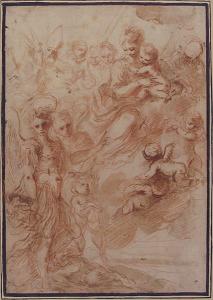2. Genesis 2:7 and the Hebrew / Biblical Idiom of Synecdoche
Lucas Banzoli is a very active Brazilian anti-Catholic polemicist, who holds to basically a Seventh-Day Adventist theology, whereby there is no such thing as a soul that consciously exists outside of a body, and no hell (soul sleep and annihilationism). This leads him to a Christology which is deficient and heterodox in terms of Christ’s human nature after His death.
This is my 36th refutation of his articles (or portions of books). As of yet, I haven’t received a single word in reply to any of them (or if Banzoli has replied to anything, anywhere, he certainly hasn’t informed me of it). Readers may decide for themselves why that is the case.
My current effort is a major multi-part response to Banzoli’s 1900-page e-book, The Legend of the Immortality of the Soul [A Lenda da Imortalidade da Alma], published on 1 August 2022. He claims to have “cover[ed] in depth all the immortalist arguments and present all the biblical proofs of the death of the soul . . .” and confidently asserts: “the immortality of the soul is at the root of almost all destructive deception and false religion.” He himself admits on page 18 of his Introduction that what he is opposing is held by “nearly all the Christians in the world.” A sincere unbiblical error (and I assume his sincerity) is no less dangerous than a deliberate lie, and we apologists will be “judged with greater strictness” for any false teachings that we spread (Jas 3:1).
I use RSV for the Bible passages (including ones that Banzoli cites) unless otherwise indicated. Google Translate is utilized to render Lucas’ Portugese into English. Occasionally I slightly modify what appear to be inadequate translations. His words will be in blue.
*****
See the other installments:
See also the related articles:
Seven Replies Re Interceding Saints (vs. Lucas Banzoli) [5-25-22]
Answer to Banzoli’s “Challenge” Re Intercession of Saints [9-20-22]
Bible on Praying Straight to God (vs. Lucas Banzoli) [9-21-22]
Reply to Banzoli’s “Analyzing the ‘evidence’ of saints’ intercession” [9-22-22]
*****
The problem with this view starts right in the second chapter of the Bible – to be more specific, in the account of the creation of man, where we read: “And the LORD God formed man of the dust of the ground, and breathed into his nostrils the breath of life; and man became a living soul.” (Genesis 2:7; KJV) “became”. Here’s the little word that makes all the difference: the beginning of the legend of a immortal soul. The author could have said — and in the opinion of the immortalists that is what he meant after all – that man “received” (laqach) a soul, but, instead, he uses the word hayah, which means “to become” or “to become”. (pp. 48-49)
In the Bible we find many texts that are difficult to interpret, but Gen[esis] 2:7 is far from being one of them. The only reason why many insist on problematizing and distorting a text so extraordinarily simple that any 10-year-old would get it right . . . is because it has deep consequences for one of the most basic beliefs of false religions. (pp. 49-50)
The “problem” of the text is not that it is “too obscure” or “difficult to interpret,” but precisely because it is clear, even too clear. It’s not the interpretation that is difficult; the difficult thing is to accept its implications. And the problem of refusing to understand such a simple text is that the clearer a text is, the greater the juggling required to “explain” it from an opposite point of view. We call this eisegesis, which is when an interpreter injects a text an idea that he wants to be there, even though it isn’t. (p. 50)
The reason immortalists have no trouble understanding these other texts, but refuse to accept the same principle in Gen[esis] 2:7, it is simply because they are committed to their dualistic presuppositions, that prevent them from understanding the text in a natural and simple way and lead them to endless conjecture – and all this to find the immortal soul in the text in any way and at any cost. In light of Gen[esis] 2:7, the only honest conclusion is that the “living soul” is nothing more than a breathing body. . . . Soul is what we are, not what we have. (pp. 51-52)
This is where we start to see the profundity and tragedy of errors on the level of premise, in the “arguments” of soul sleep advocates. As I wrote in Part 1:
One such error, for example, is often the basis of the “exegesis” (really, eisegesis) of many passages interpreted wrongly and vastly misconstrued based on the false premise.
To put it bluntly, those who hold to this line of reasoning don’t understand biblical language in its nuanced complexity. That’s 90% of the problem. Once these sorts of “wrong paths” are understood and adequately explained, the conclusions of the soul sleep advocate and their falsely alleged prooftexts fall like a house of cards or a bunch of dominoes. . . .
All it takes is a few of those [false premises] to build an entire heretical superstructure, . . .
The tortured, clueless eisegesis of Genesis 2:7 is perhaps the classic example of how those who cling to this erroneous view do not understand biblical language and figures of speech (at all). I shall comment on this at some length in order to abundantly prove that point. Note that Banzoli described Genesis 2:7 as “the beginning of the legend of a immortal soul.” He makes it clear that the presupposition of the entire biblical and traditional Christian theology of the soul that he rejects, begins in this passage, as the foundational premise. But if his premise (i.e., interpretation of the verse) is wrong (as I will now show), what becomes of the false theology built upon it? It’s a foundation of sand, and that faulty house will collapse. It’s about to do so right now, before your eyes.
Bible scholar E. W. Bullinger, in his 1104-page volume, Figures of Speech Used in the Bible (London: 1898; my hardcover copy was reprinted in 1968 by Baker Book House [Grand Rapids, Michigan]; see the online complete book link too, and the paginated Internet Archive version), dealt with over 200 figures of speech, or non-literal expressions of language in the Bible. Genesis 2:7 is one of these. The broad category of idiom used in Genesis 2:7 is what is known as Synecdoche; or Transfer. It’s so common in the Bible that Bullinger devotes 44 pages to it (pp. 613-656), with probably a few hundred examples. He defines it at the beginning of his treatment, on page 613:
A figure by which one word receives something from another which is internally associated with it by the connection of two ideas: as when a part of a thing is put by a kind of Metonymy for the whole of it, or the whole for a part. The difference between Metonymy and Synecdoché lies in this; that in Metonymy, the exchange is made between two related nouns; while in Synecdoché, the exchange is made between two associated ideas.
Bullinger describes (with copious biblical examples) four broad types of synecdoche, with five, six, five, and four sub-classifications. The form in play in Genesis 2:7 is called “synecdoche of the part”, or: “when a part is put for the whole . . . one part or member is put for, and includes, every part or member” (p. 640). The entire 44-page section can be read online (use the “+” sign to enlarge the text). Here is but one of the scores of examples Bullinger provides:
Genesis 17:14 (KJV) And the uncircumcised man child whose flesh of his foreskin is not circumcised, that soul shall be cut off from his people; he hath broken my covenant.
This passage is self-interpreting. It describes the person as a “man” and then “soul” and then “he.” Banzoli and those who follow his heresy would no doubt reply, “see?! This proves that ‘soul’ and ‘man’ are identical and that dualism [body and soul] is a false doctrine.” It does not. It proves that a synecdoche is being employed, since in many other places in Scripture, the soul (spirit also, as a synonym) is a distinct entity: a part of a person that can be referred to accordingly (i.e., the usage in those instances is literal and not figurative). For example:
Genesis 12:13 (KJV) . . . my soul shall live because of thee. (cf. 19:20: “my soul shall live”)
Genesis 34:3, 8 . . . his soul was drawn to Dinah the daughter of Jacob . . . [8] . . . The soul of my son Shechem longs for your daughter . . .
Genesis 35:18 And as her soul was departing (for she died) . . .
Genesis 42:21 . . . we saw the distress of his soul . . .
Genesis 49:6 O my soul . . .
Leviticus 17:11 . . . make atonement for your souls . . .
Deuteronomy 26:16 “This day the LORD your God commands you to do these statutes and ordinances; you shall therefore be careful to do them with all your heart and with all your soul.” (cf. 30:2, 6, 10; Josh 22:5; Mt 22:37; Mk 12:30; Lk 10:27)
1 Samuel 18:1 . . . the soul of Jonathan was knit to the soul of David . . .
1 Kings 17:21-22 Then he stretched himself upon the child three times, and cried to the LORD, “O LORD my God, let this child’s soul come into him again.” [22] And the LORD hearkened to the voice of Eli’jah; and the soul of the child came into him again, and he revived.
Isaiah 26:9 My soul yearns for thee in the night, my spirit within me earnestly seeks thee. . . .
Ecclesiastes 12:7 and the dust returns to the earth as it was, and the spirit returns to God who gave it.
Zechariah 12:1 . . . Thus says the LORD, who stretched out the heavens and founded the earth and formed the spirit of man within him:
Luke 8:55 And her spirit returned, and she got up at once; and he directed that something should be given her to eat.
Acts 17:16 Now while Paul was waiting for them at Athens, his spirit was provoked within him as he saw that the city was full of idols.
1 Corinthians 2:11 For what person knows a man’s thoughts except the spirit of the man which is in him? . . .
1 Corinthians 5:5 you are to deliver this man to Satan for the destruction of the flesh, that his spirit may be saved in the day of the Lord Jesus.
2 Corinthians 7:1 . . . let us cleanse ourselves from every defilement of body and spirit . . .
Galatians 6:18 The grace of our Lord Jesus Christ be with your spirit, brethren. Amen. (cf. Phil 4:23; 2 Tim 4:22; Philem 1:25)
James 4:5 Or do you suppose it is in vain that the scripture says, “He yearns jealously over the spirit which he has made to dwell in us”?
Revelation 22:6 . . . the Lord, the God of the spirits of the prophets, . . .
[see dozens and dozens of additional examples of “soul” in the Old Testament]
Now Banzoli and his fellow heretics may claim this was only in the Old Testament, and thus readily dismissed. It was not. There are many such examples of dualism in the New Testament as well (including right from the mouth of our Lord Jesus):
Matthew 10:28 . . . both soul and body . . .
Matthew 11:29 . . . you will find rest for your souls.
Matthew 26:38 . . . My soul is very sorrowful . . .
Luke 1:46 And Mary said, “My soul magnifies the Lord,
Acts 14:22 strengthening the souls of the disciples, . . .
1 Thessalonians 5:23 may your spirit and soul and body be kept sound and blameless at the coming of our Lord Jesus Christ. (cf. Heb 4:12)
Hebrews 10:39 . . . those who have faith and keep their souls.
James 1:21 . . . the implanted word, which is able to save your souls.
1 Peter 1:9, 22 As the outcome of your faith you obtain the salvation of your souls. . . . [22] Having purified your souls by your obedience to the truth . . .
1 Peter 4:19 . . . entrust their souls to a faithful Creator.
3 John 1:2 . . . I know that it is well with your soul.
After providing many examples of figurative synecdoche with regard to “soul = man”, Bullinger also notes analogous biblical usages of synecdoche; for example: “The Body is put for the person himself” (p. 641). He notes that we do that today, by saying ” ‘a hand’ for a workman.” Here are some of his examples for this similar non-literal biblical language:
Romans 12:1 . . . present your bodies as a living sacrifice, . . .
James 3:6 . . . The tongue is an unrighteous world among our members, staining the whole body . . .
Another similar idiom is “the flesh [being] put for the whole person” (p. 642):
Genesis 6:12 . . . all flesh had corrupted their way upon the earth.
Psalm 145:21 . . . let all flesh bless his holy name for ever and ever.
Isaiah 40:5 And the glory of the LORD shall be revealed, and all flesh shall see it together,
Matthew 19:5 . . . the two shall become one flesh
Romans 3:20 (KJV) . . . by the deeds of the law there shall no flesh be justified . . .
1 Peter 1:24 for “All flesh is like grass . . .
Here’s another similar use of synecdoche. We saw “soul” (a part) being used for the whole (a man). Now, we see “The head is put for the man himself” (p. 645):
Psalm 7:16 His mischief returns upon his own head, . . .
Proverbs 10:6 Blessings are on the head of the righteous, . . .
Isaiah 35:10 . . . everlasting joy shall be upon their heads; they shall obtain joy and gladness, . . .
2 Samuel 1:16 And David said to him, “Your blood be upon your head; . . .
This is a double idiom or figure of speech in one verse; synecdoche (head for man) and what is called “metonymy of the effect”: using the word “blood” for the guilt of blood-shedding. Hence, when the Jews rejected Paul’s gospel-preaching, he exclaimed in the same fashion: “Your blood be upon your heads!” (Acts 18:6).
Hebrew / Jewish language in the Bible and in that ancient Near Eastern culture was filled with idiomatic, figurative, non-literal expressions (as is English today and, I think, all languages to more or less degrees).
Here are some other uses of synecdoche in Scripture, describing a man by only part of his body: face (Ps 132:10: “do not turn away the face of thy anointed one”; Lam 5:12 [KJV]: “the faces of elders were not honoured”), mouth (Pr 8:13 [KJV]: “the froward mouth, do I hate”), and feet (Pr 1:16: “their feet run to evil”; cf. Rom 3:15, citing the OT: “Their feet are swift to shed blood”).
Not grasping this undeniable factor of massive non-literal language of many types has by itself unfortunately brought about much heretical teaching and lousy, clueless biblical “interpretation.” It’s simply an ignorance of one aspect of many with respect to the nature of the language and thinking of Holy Scripture. People don’t comprehend this, and so prefer to mock and put down others who do, insinuating that they can’t see the “plain” (i.e., literal) meaning of the Bible, when in fact the passage is idiomatic. Jehovah’s Witnesses (my first big study topic as an apologist in 1981) are infamous “masters” at this, and all the other cults and insufficiently biblical Christians like Lucas Banzoli make the same huge category and hermeneutical error.
Because of his lack of understanding, we see Banzoli engaging in this mockery above (“any 10-year-old would get it right”) . . . In fact, the “last laugh” is on him. The ten-year-old has a good excuse for not getting the interpretation of a biblical text or doctrine right (lack of education, ignorance, inexperience). Banzoli has none of these excuses. He is intelligent and theologically educated. He knows far better than this. He’s simply given in to “itching ears” (2 Tim 4:3) in his adoption of the slop and refuse of this thoroughly anti-biblical heretical error.
Proverbs 29:9 If a wise man has an argument with a fool, the fool only rages and laughs, and there is no quiet.
Ecclesiastes 7:6 For as the crackling of thorns under a pot, so is the laughter of the fools; this also is vanity.
Ironically, however, later in his book, Banzoli shows that he does understand the same principle of synecdoche, which is in play in Genesis 2:7:
The soul is not only used in parallel with the body, but also with body parts. For example, the psalmist claims that “For our soul is bowed down to the dust: our belly cleaveth unto the earth” (Ps 44:25 [KJV]), where “soul” and “belly” are taken as equivalent, even though they are not the same thing. The same thing occurs in the text where the sage says that his words “will be life for your soul and adornment for your neck” (Pr 3:22), . . . (p. 72)
So he understands that the idiom occurs in these passages, but fails to perceive that it is also present in Genesis 2:7. And he does so in the latter instance because he is already predisposed to reject the biblical, traditional teaching on the soul, and so misinterprets and twists and eisegetes Genesis 2:7 in order to force-fit it into that false notion.
On the other hand, though he describes a synecdoche, as used in the two passages above (“. . . taken as equivalent, even though they are not the same thing”), he’s not aware of the fact that a synecdoche is in play, since he never uses the word (sinédoque in Portugese) in his 1900-page book. Unless there is another Portugese word for this, Banzoli has shown no awareness (in terms of identifying the name) of this relevant factor for the proper interpretation of many biblical passages.
***
Practical Matters: Perhaps some of my 4,000+ free online articles (the most comprehensive “one-stop” Catholic apologetics site) or fifty books have helped you (by God’s grace) to decide to become Catholic or to return to the Church, or better understand some doctrines and why we believe them.
Or you may believe my work is worthy to support for the purpose of apologetics and evangelism in general. If so, please seriously consider a much-needed financial contribution. I’m always in need of more funds: especially monthly support. “The laborer is worthy of his wages” (1 Tim 5:18, NKJV). 1 December 2021 was my 20th anniversary as a full-time Catholic apologist, and February 2022 marked the 25th anniversary of my blog.
PayPal donations are the easiest: just send to my email address: [email protected]. You’ll see the term “Catholic Used Book Service”, which is my old side-business. To learn about the different methods of contributing, including 100% tax deduction, etc., see my page: About Catholic Apologist Dave Armstrong / Donation Information. Thanks a million from the bottom of my heart!
***
Photo credit: Saint Michael the Archangel and Another Figure Recommending a Soul to the Virgin and Child in Heaven, by Bartolomeo Biscaino (1629-1657) [public domain / Wikimedia Commons]
***
Summary: Part 2 of many responses to Lucas Banzoli’s 1900-page book, The Legend of the Immortality of the Soul: published on 1 August 2022. I defend historic Christianity.














